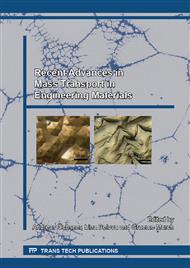p.27
p.33
p.39
p.51
p.61
p.73
p.83
p.91
p.101
Design and Development of Nb-W-Mo Alloy Membrane for Hydrogen Separation and Purification
Abstract:
The concept for alloy design of Nbbased hydrogen permeable membrane is applied to NbWMo ternary system. The alloying effects of tungsten and molybdenum on the solubility of hydrogen, the resistance to hydrogen embrittlement, the hydrogen permeability and diffusivity are investigated in a fundamental manner. It is found that the addition of tungsten and molybdenum into niobium decreases the hydrogen solubility. As a result, the resistance to hydrogen embrittlement improves and higher hydrogen pressures can be applied to the NbWMo alloy membrane. It is shown that the designed Nb5mol%W5mol%Mo alloy membrane with single solid solution phase exhibits excellent hydrogen permeability together with strong resistance to hydrogen embrittlement. In addition, it is found that the alloying of tungsten and molybdenum with niobium enhances the hydrogen diffusivity. In fact, the activation energy for hydrogen diffusion decreases in the order, pure Nb > Nb5mol%W > Nb5mol%W5mol%Mo.
Info:
Periodical:
Pages:
61-71
Citation:
Online since:
January 2013
Authors:
Price:
Сopyright:
© 2013 Trans Tech Publications Ltd. All Rights Reserved
Share:
Citation:



